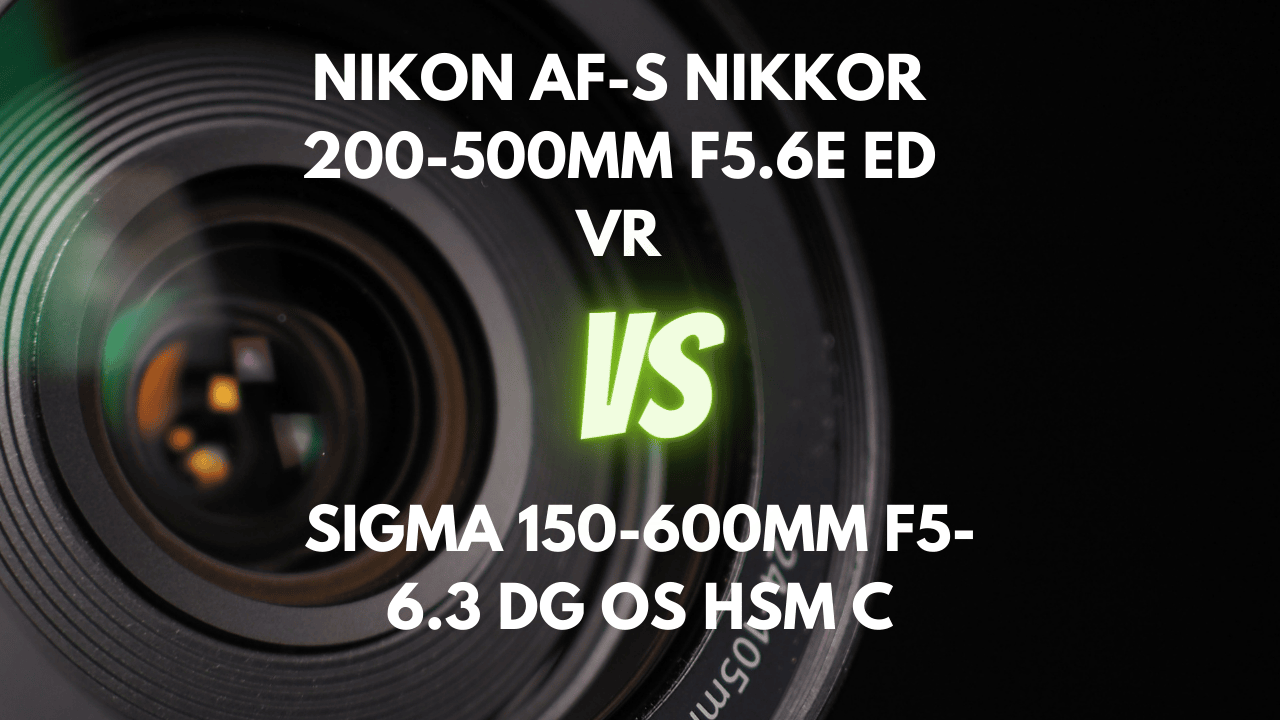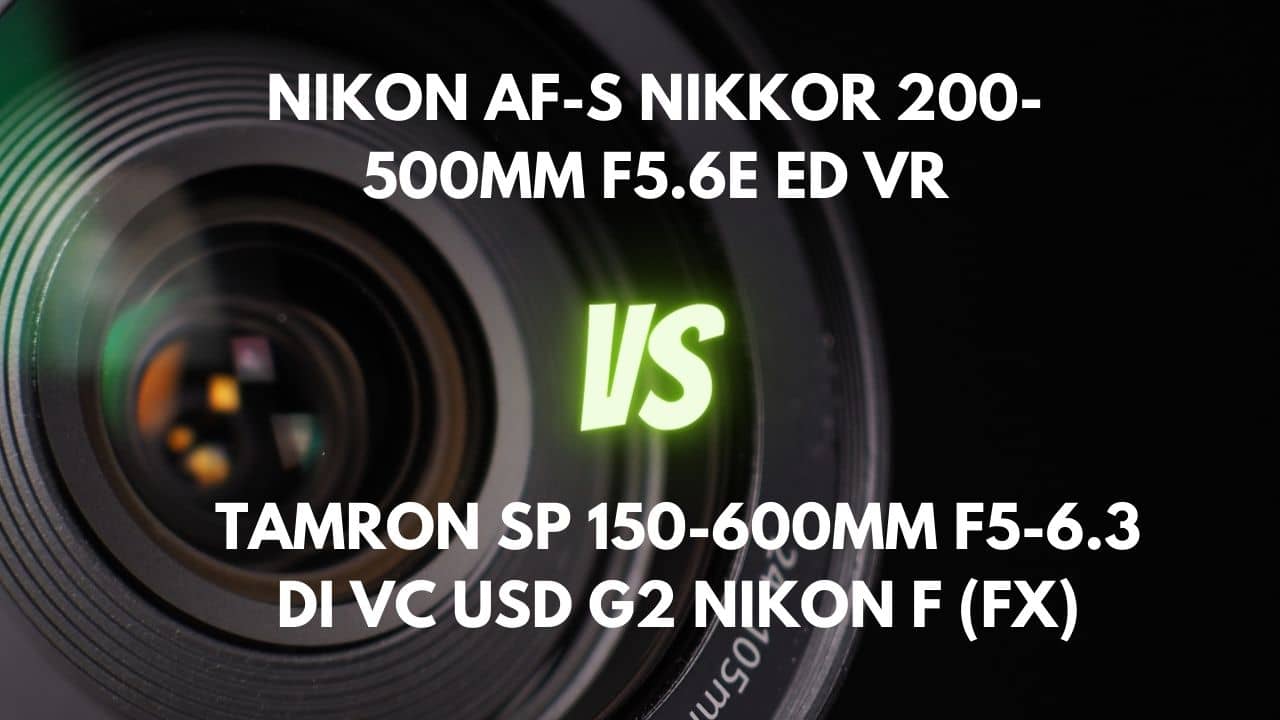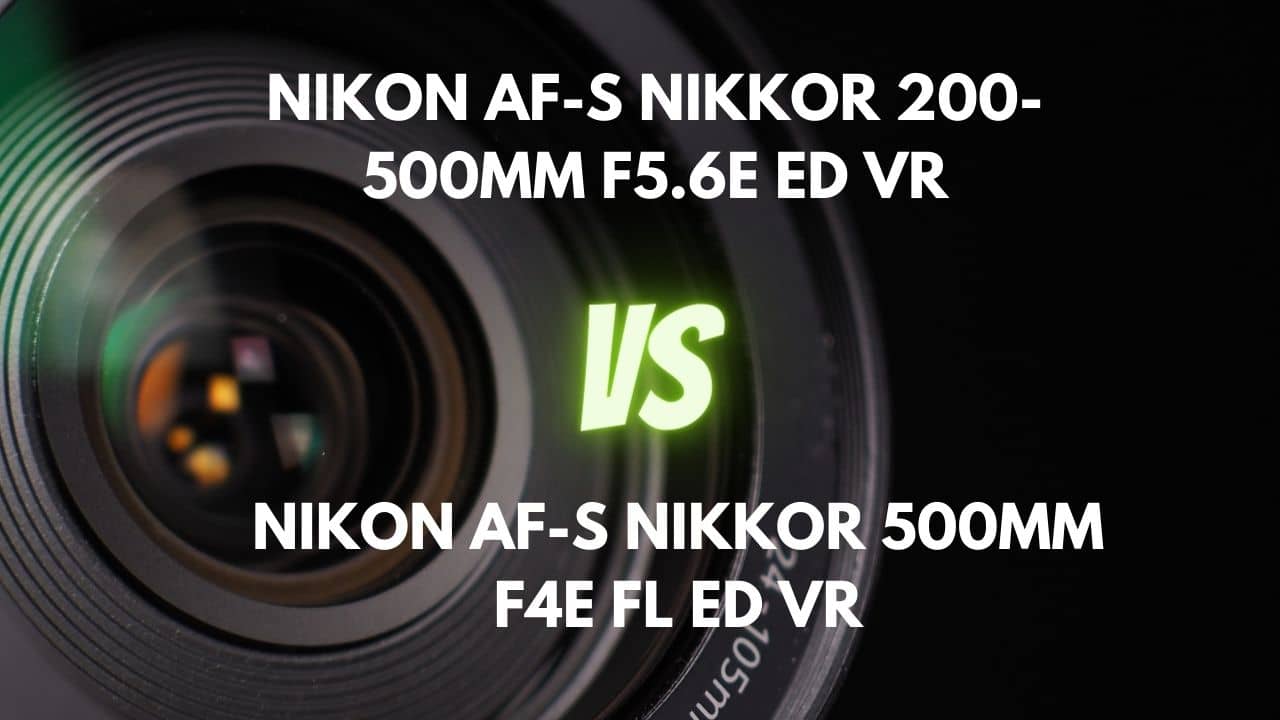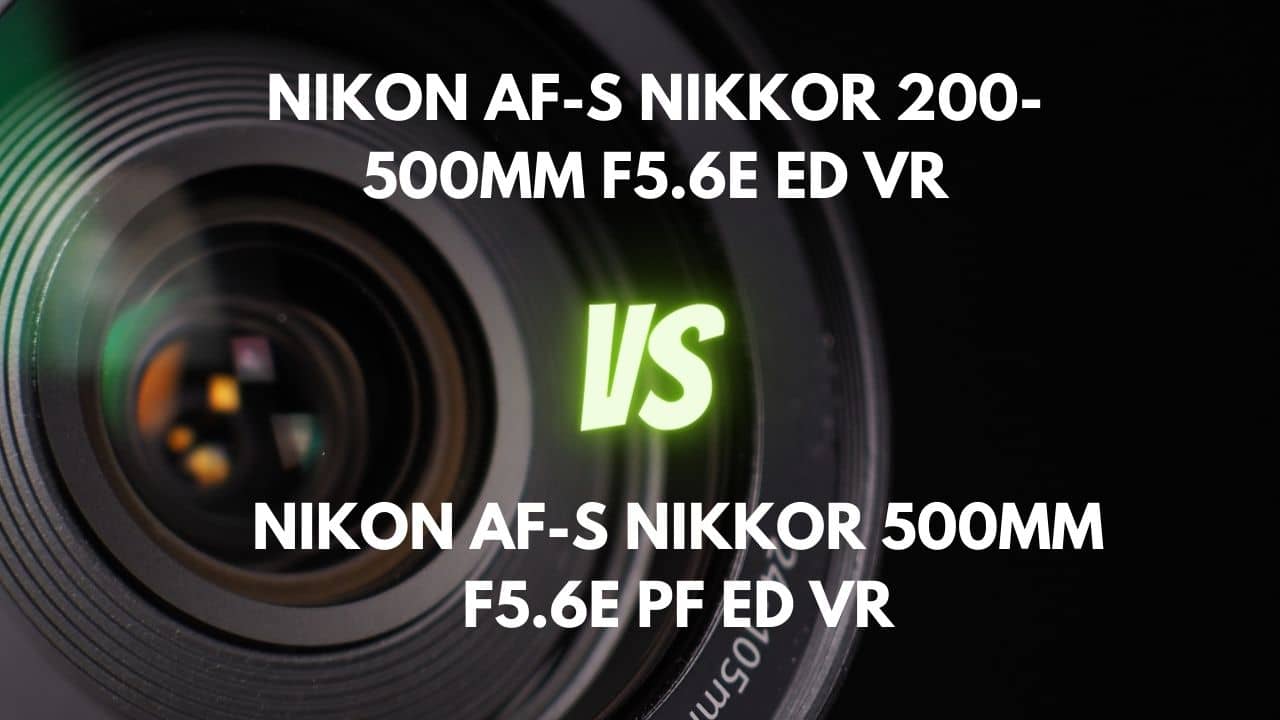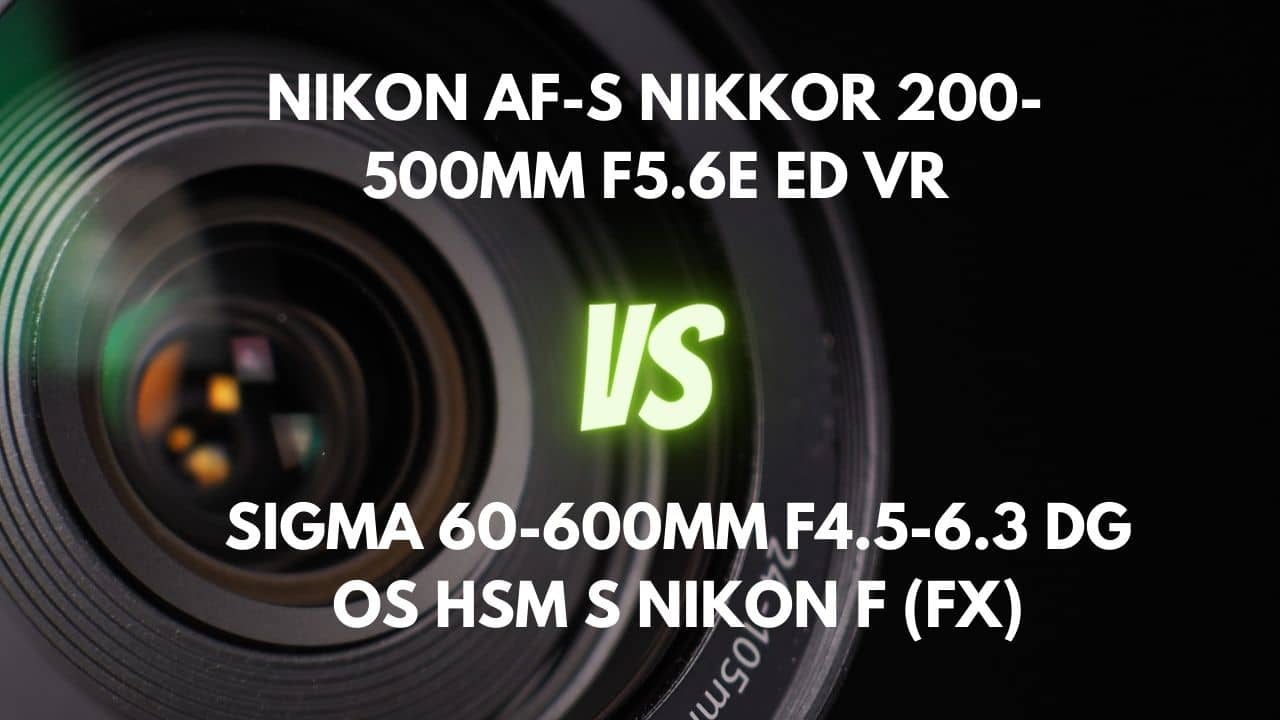Are you a passionate sports or wildlife photographer on the lookout for the perfect telephoto zoom lens? Look no further, as we dive deep into a detailed comparison between two highly regarded contenders: Nikon 200-500mm f/5.6 and Sigma 150-600mm f/5-6.3 Sports.
We understand that capturing the decisive moment in fast-paced action or immortalizing a rare wildlife encounter requires a top-performing lens that caters to your specific needs. In this article, we will explore the ins and outs of these two lenses, comparing their build quality, autofocus performance, image stabilization, sharpness, and more, to help you make the most informed decision.
Not only will this comparison provide you with a comprehensive understanding of each lens’s strengths and weaknesses, but it will also help you identify the lens that complements your unique shooting style and requirements.
Whether you prioritize flexibility, weather sealing, or exceptional sharpness, this article will unveil the benefits of each lens, empowering you to elevate your sports and wildlife photography to new heights.
So, let’s embark on this captivating journey to discover which of these telephoto zoom lenses is the ideal match for your photography aspirations.
Overview
| Nikon AF-S NIKKOR 200-500mm F5.6E ED VR | Sigma 150-600mm F5-6.3 DG OS HSM S Nikon F (FX) | |
|---|---|---|
| Max Aperture | F5.6 | F5-6.3 |
| Aperture Type | Fixed | Variable |
| Focal Range (mm) | 200-500 | 150-600 |
| Mount Type | Nikon F (FX) | Nikon F (FX) |
| Zoom Ratio (X) | 2.5 | 4 |
The Nikon 200-500mm f/5.6 has a fixed aperture of f/5.6, while the Sigma 150-600mm f/5-6.3 Sports has a variable aperture of f/5-6.3. A fixed aperture lens generally provides better low light performance and consistent image quality across the zoom range, making the Nikon lens a strong choice for sports and wildlife photography. However, the Sigma lens has a broader focal range (150-600mm) compared to the Nikon lens (200-500mm), offering more flexibility for different shooting situations.
In conclusion, both lenses have their strengths and weaknesses, making the choice dependent on your specific needs and preferences. The Nikon lens, with its fixed aperture, might be better suited for photographers prioritizing consistency. On the other hand, the Sigma lens, with its broader focal range and larger maximum aperture at shorter focal lengths, offers greater flexibility for various shooting situations.
Design and Ease of Use
| Nikon AF-S NIKKOR 200-500mm F5.6E ED VR | Sigma 150-600mm F5-6.3 DG OS HSM S Nikon F (FX) | |
|---|---|---|
| Diameter x Length (mm) | ⌀108×267.5mm | ⌀121×290mm |
| Weight (gr) | 2300 | 2860 |
| Filter Thread (mm) | 95 | 105 |
| Weather Sealing | No | Yes |
| Zoom Method | Rotary (extending) | Rotary (extending) |
| Distance Scale | Yes | Yes |
| DoF Scale | No | No |
| Hood Supplied | Yes | Yes |
| Tripod Collar | Yes | Yes |
The Nikon 200-500mm f/5.6 has dimensions of ⌀108×267.5mm and weighs 2300 grams, while the Sigma 150-600mm f/5-6.3 Sports is larger and heavier with dimensions of ⌀121×290mm and a weight of 2860 grams. The smaller size and lighter weight of the Nikon lens offer several advantages in sports and wildlife photography.
Portability is an essential factor in these genres, as photographers often need to carry their gear for extended periods. The Nikon lens, being lighter and more compact, would be easier to carry around and less tiring, allowing you to shoot for longer without feeling weighed down.
Balance is another crucial aspect to consider, as it can impact the overall handling and comfort of your camera setup. The Nikon lens, being smaller and lighter, would likely provide better balance when mounted on a camera, making it more comfortable to hold and maneuver during long shoots.
Discreetness can be a significant advantage in wildlife photography, where blending in with the surroundings is necessary to capture candid shots without disturbing the subjects. The Nikon lens, due to its smaller size, would make you less conspicuous compared to the larger Sigma lens.
Storage is another area where the Nikon lens has an edge, as its compact size will take up less space in your camera bag, leaving room for additional gear or making your bag lighter and easier to carry.
Finally, lens swapping is often necessary in fast-paced environments like sports photography. The lighter Nikon lens would be easier to handle when swapping lenses quickly, helping you capture the perfect shot in dynamic situations.
In conclusion, the Nikon lens’s smaller size and lighter weight make it a superior choice for sports and wildlife photography, offering improved portability, balance, discreetness, storage, and ease of lens swapping compared to the larger and heavier Sigma lens. The choice ultimately comes down to your specific needs and priorities as a photographer, but the Nikon lens offers several advantages that make it an appealing option in these genres.
Lens Mount and Barrel
The Nikon 200-500mm f/5.6 features a metal lens mount with a rubber gasket, providing protection against dust and moisture. On the other hand, the Sigma lens has a metal lens mount as well, with a weather sealing gasket around its edge. Both lens mounts offer durability and protection for the lenses, ensuring long-lasting performance and safeguarding the lenses from the elements.
The lens barrel of the Nikon lens consists of a metal outer barrel with a high-grade plastic shell and a plastic inner barrel. This combination of materials offers a balance between durability and weight. The lens telescopes when zooming, and there’s a lock at the shortest 200mm length to prevent unwanted focal length changes due to gravity. Although the lens becomes longer when zoomed in, it maintains good balance with the camera.
In contrast, the lens barrel of Sigma 150-600mm f/5-6.3 Sports is made from a mix of aluminum, TSC (Thermally Stable Composite), and plastic, which provides durability and a lightweight feel. Its ergonomic design includes rubberized surfaces and ridges for comfortable grip and smooth operation. The lens changes its physical size when zooming in or out, extending notably at maximum zoom, which may affect the center of gravity and require additional support for optimal handling.
In conclusion, both the Nikon and Sigma lenses have durable lens mounts and well-constructed lens barrels that combine different materials for optimal performance. The Nikon lens offers better balance when zooming, while the Sigma lens provides an ergonomic design for comfortable handling.
Weather Sealing
The Nikon 200-500mm f/5.6 offers partial weather sealing, featuring a rubber gasket at the lens mount to protect against water ingress. On the other hand, the lens lacks internal seals at the rings and switches, as well as on the front of the barrel. Additionally, there is no fluorine coating on the front element to repel water and make cleaning easier. While it can withstand some cold, dust, and moisture, it is not designed for heavy abuse or extreme weather conditions like a pro-level lens.
In contrast, the Sigma 150-600mm f/5-6.3 Sports has more comprehensive weather sealing, including a gasket at the lens mount and seals around the switches to prevent moisture and dust from entering. The front element has a fluorine coating, which helps repel water and oil, making it more resistant to the elements. Although not fully sealed against extreme conditions like some high-end models, it provides reliable protection for most shooting situations.
Weather sealing involves using gaskets, seals, and special coatings to protect a lens from dust, moisture, and light water splashes. Fully weather-sealed lenses offer better protection, durability, and performance in challenging environments, making them suitable for outdoor photography in various conditions.
Based on the information provided, the Sigma lens has superior weather sealing compared to the Nikon lens. This added protection makes it more suitable for photographers who frequently shoot in harsh or unpredictable conditions, offering enhanced durability and performance.
Rings
The Nikon 200-500mm f/5.6 features two rings: a ribbed zoom ring and a textured rubber focus ring, both designed for smooth rotation and a quality feel. The zoom ring is positioned towards the front of the lens, taking almost 180 degrees of rotation to zoom from 200mm to 500mm.
By positioning the focus ring closer to the camera body, you can easily adjust the focal length without sacrificing balance or grip. Additionally, the lens comes equipped with a zoom lock switch at its shortest 200mm length to prevent any unintentional zooming, as well as a focus limiter function and full-time manual focus override when set to the M/A position. A windowed distance scale is also present.
The Sigma 150-600mm f/5-6.3 Sports has two rings: a rubberized focus ring and a ridged rubber zoom ring. The focus ring, positioned in front of the tripod mount ring, offers variable adjustment based on rotation speed for precise manual focusing. However, it may be hard to grasp when the lens is mounted directly on a tripod.
The zoom ring has marks for various focal lengths and a switch to prevent zoom creep when tilting the lens. Additionally, it offers two zoom ring resistance settings along with a fully-retracted lock. The lens is designed for both twist zoom and push/pull operation, with the zoom ring being larger and smooth but slightly sticky. A windowed distance scale is featured on this lens as well.
In terms of ring design, both lenses offer good ergonomics and precise control, with each having its unique advantages. The Nikon lens has a more comfortable focus ring placement, while the Sigma lens provides a variable adjustment rate for fine-tuned manual focusing. The larger zoom ring on the Sigma lens may offer better grip and ease of use, but the Nikon lens has smoother rotation.
Switches/Buttons
On the side of the Nikon 200-500mm f/5.6, you’ll find four conveniently located switches, including an AF/MF switch, a focus limiter switch, an IS switch, and a VR mode switch. The AF/MF switch provides you with full-time manual focus override, and the focus limiter switch lets you narrow down the autofocus distance to a specific range. The IS switch gives you control over the vibration reduction system, and the VR mode switch allows you to toggle between normal and sport mode. Additionally, the focus and zoom rings are thoughtfully designed and textured for comfortable handling.
On the other hand, the Sigma 150-600mm f/5-6.3 Sports has a well-organized layout with four main switches located near the mounting point: the focus mode switch, the focus limiter, the OS (Optical Stabilizer) switch, and a custom mode switch. The focus mode switch provides autofocus (AF), manual focus (MF), and manual override (MO) options.
The focus limiter allows for range restrictions, and the OS switch offers optical stabilization control. The custom mode switch, exclusive to the Leica L-mount version, can be personalized via Sigma’s USB dock for enhanced autofocus and optical stabilization control. Most of the switches have three positions, with firm resistance and solid clicks for easy selection. White backgrounds on the AF/MF and Zoom Torque switches improve usability by indicating their positions.
In conclusion, both the Nikon and Sigma lenses offer an array of well-designed switches for easy control and customization. However, the Sigma lens edges out the Nikon lens in terms of superior features like the custom mode switch and the manual override (MO) option, making it the better choice for photographers seeking more advanced control and flexibility.
Filter Thread
The Nikon 200-500mm f/5.6 has a 95mm filter thread size, which is less common compared to other sizes. Made of metal, the filter thread offers durability and a secure fit for filters. During focusing, the front element and filter thread do not rotate, making it convenient to use with filters like polarizers and graduated neutral density filters. Though 95mm filters may be less common, high-quality filters from reputable brands such as B+W and Hoya are available for this lens, providing excellent protection and performance.
The Sigma 150-600mm f/5-6.3 Sports also features a 95mm filter thread size, which is smaller and less expensive than the 105mm filters used by its predecessor. The metal filter thread accepts standard threaded filters, and like the Nikon lens, the Sigma lens does not rotate on focus, making it easy to use with filters.
Both lenses have 95mm filter thread sizes, providing similar compatibility and filter options. The metal material used in both lenses ensures durability and a secure fit for filters. As both lenses’ front elements and filter threads do not rotate during focusing, they are equally convenient for use with various filters. Given these similarities, neither lens has a clear advantage in terms of filter thread design.
Lens Hood
The Nikon 200-500mm f/5.6 comes with a one-piece plastic bayonet design lens hood, which is included in the package. It can be reversed for transportation and is quite large, with a 5″ diameter and 4″ length. The lens hood is made of plastic and has a smooth finish, allowing for easy rotation. This design effectively blocks unwanted light and offers protection to the front lens element.
In contrast, the Sigma 150-600mm f/5-6.3 Sports features an aluminum lens hood that is also included in the package. It has a premium feel due to its aluminum construction and uses a tension knob for secure locking instead of a traditional bayonet lock. The hood is well-crafted with a rubberized surface at the front that helps absorb shock. Additionally, the flat end of the hood allows the lens to stand upright on a smooth surface without scratching the hood or the surface it’s resting on, thanks to the grippy rubberized surface on the end of the hood.
While both lens hoods provide protection and prevent unwanted light from entering the lens, the Sigma lens hood has a more premium construction and additional features. The aluminum build, tension knob lock, and rubberized surface for shock absorption make the Sigma lens hood superior to the Nikon lens hood in terms of material, design, and functionality.
Tripod Collar
The Nikon 200-500mm f/5.6 features a tripod collar designed to support its weight and ensure stability when using a tripod. The collar has a single point of connection situated far back on the lens barrel, which could be enhanced with a two-point stabilization system, similar to those used by Kirk and RRS replacement lens collars.
Although the tripod collar is not directly compatible with Arca-Swiss, many photographers choose to replace the stock collar with an aftermarket one that offers improved support and compatibility. The tripod collar is removable for more comfortable handheld use.
In contrast, the Sigma 150-600mm f/5-6.3 Sports comes with a removable tripod collar situated near the base of the lens with a thumb screw for tightening and setting its position. The collar has stops at 90-degree intervals for easy rotation between landscape and portrait modes.
The foot of the collar is well-built, offering three separate locking positions for tripod use. It is grooved for Arca standard clamps and accessories, but some clamps may require the addition of gaffer tape to the foot groove for a secure fit. While the collar itself is not removable, the low-profile tripod foot can be removed or replaced with another variant.
In conclusion, both the Nikon and Sigma lenses have tripod collars designed to provide stability and support. However, the Sigma lens has an edge over the Nikon lens, as its collar offers greater compatibility with Arca standard clamps and accessories and provides more locking positions for tripod use. The built-in stops for easy rotation between landscape and portrait modes also make the Sigma lens superior for sports and wildlife photography, where versatility and ease of use are crucial.
Focusing and Optical Stabilization
| Nikon AF-S NIKKOR 200-500mm F5.6E ED VR | Sigma 150-600mm F5-6.3 DG OS HSM S Nikon F (FX) | |
|---|---|---|
| Autofocus | Yes | Yes |
| AF Motor | Silent Wave Motor | Hyper Sonic Motor |
| Rotating Front Element | Does not rotate on focusing | Does not rotate on focusing |
| Min Focus Distance | 2.2m | 2.6m |
| Max Magnification (X) | 0.22 | 0.2 |
| Full-Time Manual Focus | Yes | Yes |
| Focus Method | Internal | Internal |
Focusing Performance
The Nikon 200-500mm f/5.6 boasts a built-in Silent Wave Motor (SWM) that delivers quiet autofocus operation and allows for full-time manual focus override when set to the M/A position. Its autofocus speed is impressive, with initial focus acquisition being faster than many f/1.8 Nikon primes. Focusing from close to infinity takes about 1 second at 500mm and 0.7 seconds at 300mm.
Low-light performance is generally good, but may slightly slow down at 500mm. The lens excels in focusing accurately and consistently, with excellent repeatability. Its manual focus action is smooth, and the wide focus ring ensures precise focus adjustment. Additionally, the internally focusing design keeps the length constant and prevents the front element from rotating during focusing, making it convenient for polarizing filters.
On the other hand, the Sigma 150-600mm f/5-6.3 Sports offers nearly silent and relatively fast autofocus performance, with an impressive initial autofocus acquisition speed. It can focus accurately and consistently, even in low-light situations, although low-light focusing can be slow.
The manual focus override (MO) is available for manual adjustments after autofocus has locked. The manual focus action is smooth, and the internally focusing design maintains a constant length and prevents front element rotation during focusing. Focus breathing is minimal, mostly noticeable at close focus distances.
In conclusion, both the Nikon and Sigma lenses provide excellent focusing performance suitable for sports and wildlife photography. However, the Nikon lens has a slight advantage in terms of autofocus speed and repeatability. While both lenses offer smooth manual focus action and internally focusing designs, the Nikon lens is better suited for situations that demand fast and accurate focusing, making it the superior choice for sports and wildlife photographers.
Optical Stabilization
The Nikon 200-500mm f/5.6 is equipped with an effective Vibration Reduction (VR) system, providing up to 4.5 stops of stabilization, which allows for sharp images even at slower shutter speeds. The VR system operates silently, making it well-suited for both photography and video recording.
It offers two stabilization modes: Normal and Sport, with Sport mode specifically designed for tracking fast-moving subjects. With the lens set to 500mm and VR on, shutter speeds as slow as 1/60 seconds can produce usable shots, and in some cases, even down to 1/25 seconds, showcasing the impressive stabilization performance.
In comparison, the Sigma 150-600mm f/5-6.3 Sports features an optical stabilization system with two modes: Position 1 for general photography and Position 2 for panning while capturing moving subjects. The stabilization system allows for sharp handheld shots at shutter speeds as low as 1/100-second when set to 600mm.
Some blur may occur at 1/50-second, but images still appear acceptable at web resolution. Achieving consistent sharp results becomes more challenging at 1/20-second, with most images showing blur. The lens has a quiet stabilization system, which proves effective in the field, especially when used with a monopod or handheld.
In conclusion, both the Nikon and Sigma lenses offer reliable optical stabilization systems. However, the Nikon lens has a slight edge with its 4.5 stops of stabilization and better performance at slower shutter speeds. This makes the Nikon lens the superior choice for photographers seeking enhanced optical stabilization in challenging shooting conditions.
Image Quality
| Nikon AF-S NIKKOR 200-500mm F5.6E ED VR | Sigma 150-600mm F5-6.3 DG OS HSM S Nikon F (FX) | |
|---|---|---|
| Special Elements | 3 ED elements | 2 FLD and 3 SLD |
| Diaphragm Blades | 9 | 9 |
Aberration
The Nikon 200-500mm f/5.6 performs quite well in terms of aberration control, exhibiting minimal chromatic aberration even on high contrast edges. Chromatic aberration levels are low at 200mm and 300mm, but increase slightly as you approach 400mm and 500mm focal lengths.
The lens does show some cat’s-eye effect towards the borders/corners of the sensor, noticeable coma, and the bokeh has a mild “onion-ring” effect. However, spherical aberration is significantly reduced by the extra-low dispersion lens elements, which contributes to the overall sharpness and contrast of the lens.
On the other hand, the Sigma 150-600mm f/5-6.3 Sports exhibits some typical aberrations, such as axial chromatic aberration, spherical aberration, and spherochromatism, which can lead to less sharp and hazy image quality at the widest apertures. Stopping down by one or two stops usually eliminates the spherical aberration color halo.
Lateral chromatic aberration can often be corrected easily using the appropriate lens profile and software. The lens has modest pincushion distortion at 150mm, which can be easily removed with correction profiles. From a wide-open aperture throughout the entire focal length range, the lens produces sharp peripheral results.
In conclusion, both lenses exhibit some level of aberration, but the Nikon lens demonstrates better control over chromatic aberration and benefits from the use of extra-low dispersion lens elements to reduce spherical aberration. As a result, the Nikon lens offers superior aberration performance, providing sharper and more contrasty images compared to the Sigma lens.
Sharpness
Throughout the zoom range, the Nikon 200-500mm f/5.6 displays impressive center sharpness. However, at longer focal lengths and wide open apertures, there may be some corner softness present. Stopping down to around f/11 improves corner sharpness. At 200mm, the lens exhibits very good center sharpness at f/5.6, reaching excellent levels at f/8. However, sharpness tends to drop as you zoom in, with a noticeable decline at 500mm, although it remains usable. The use of a teleconverter can potentially have a negative impact on autofocus accuracy and further reduce overall sharpness.
In contrast, the Sigma 150-600mm f/5-6.3 Sports displays good sharpness throughout the zoom range, with the center generally being sharper than the corners. At wide open apertures, center sharpness is quite impressive, while corners can be a bit soft. Stopping down to f/8 or f/11 typically results in a punchier image with increased sharpness and contrast across the entire frame. Beyond f/11, sharpness may decline due to diffraction. The sharpest aperture is often f/8.
In conclusion, both lenses offer commendable sharpness, but the Nikon lens outperforms the Sigma lens in terms of center sharpness and overall performance throughout the zoom range. While the Sigma lens still delivers satisfactory sharpness, especially when stopped down, the Nikon lens provides a more consistently sharp image, making it the superior choice for sharpness.
Bokeh Quality
The Nikon 200-500mm f/5.6 generates pleasing bokeh quality, with smooth and beautiful out-of-focus areas. Its iris diaphragm is equipped with 9 rounded aperture blades, which contribute to the attractive rendition of out-of-focus areas.
The lens effectively handles specular highlights and background isolation, producing appealing bokeh without any onion-shaped highlights or distracting patterns. The bokeh balls exhibit very low longitudinal chromatic aberration, and although the cat’s-eye effect is present, it is not overly intrusive.
On the other hand, the Sigma 150-600mm f/5-6.3 Sports produces smooth and beautiful bokeh as well, thanks to its 9 rounded-blade aperture design, which contributes to nicely shaped bokeh highlights even when stopped down. This lens excels at creating outstanding background and foreground blur, providing a pleasing separation between the subject and background.
At 600mm, the compression effect enhances background separation, giving a smooth and lovely appearance to the bokeh. Despite having a narrow aperture, the f/11 highlight shapes remain nicely rounded, and the bokeh continues to be visually appealing in various scenarios.
In conclusion, both lenses offer impressive bokeh quality, with smooth and beautiful out-of-focus areas. While the Nikon lens handles specular highlights and background isolation more effectively, the Sigma lens performs exceptionally well at longer focal lengths. The choice between the two may come down to personal preference, as both lenses produce visually appealing bokeh in their respective situations.
Flare/Ghosting
The Nikon 200-500mm f/5.6 demonstrates good flare-resistance, although ghosting and flare can still pose a problem when a strong light source is directly in the frame or near the edge of the image. Nonetheless, when the light is clearly outside the image frame, no artifacts are produced. The flare patterns generated by this lens are simple and without additional coloration. While the flare and ghosting performance is good, it’s crucial to be cautious of strong light sources directly outside the frame.
In contrast, the Sigma 150-600mm f/5-6.3 Sports employs a Super Multi-Layer Coating to combat flare, which can cause reduced contrast and destructive visual artifacts when bright light reflects off the lens elements’ surfaces. However, when bright lights are present, flaring and a loss of contrast may still occur, especially with telephoto lenses like this one. To help mitigate this issue, the lens comes with a deep hood. Generally, the Sigma lens performs decently in flare tests and doesn’t exhibit significant ghosting.
In conclusion, both lenses offer respectable flare and ghosting performance. The Nikon lens has good flare-resistance, while the Sigma lens uses a Super Multi-Layer Coating to minimize flare-related issues.
Vignetting
When focused at infinity and at focal lengths beyond 300mm, the Nikon 200-500mm f/5.6 does an impressive job of controlling vignetting, with only minor darkening of the edges. At shorter focal lengths, vignetting is almost non-existent. Although some vignetting may be present, it can be corrected in post-processing, and in some cases, it can add a charming quality to your images.
On the other hand, the Sigma 150-600mm f/5-6.3 Sports displays varying degrees of vignetting at wider aperture settings, most noticeable in scenes with even lighting or plain surfaces. The degree of vignetting can be reduced by stopping down the aperture and can also be corrected during post-processing, potentially increasing noise in the brightened areas. Some images may benefit from embracing the vignetting effect to draw attention to the center of the frame, while others may require correction for a cleaner image.
In conclusion, both lenses exhibit vignetting to some extent, with the Nikon lens demonstrating better control over this effect. The Sigma lens experiences more noticeable vignetting, but it can be managed by stopping down the aperture or using post-processing software. The superior lens in terms of vignetting would be the Nikon lens, but personal preferences and shooting conditions may also influence your choice.
Distortion
Across various settings and distances, the Nikon 200-500mm f/5.6 shows minimal pincushion distortion. While it may not be noticeable in real-world scenarios, most Nikon DSLRs have automatic correction for this type of distortion, and it can also be corrected using post-processing tools such as Photoshop’s Lens Distortion tool. Despite these imperfections, the lens still produces sharp images with minimal linear distortion, making any distortion manageable and easy to correct in post-processing.
The Sigma 150-600mm f/5-6.3 Sports exhibits modest pincushion distortion at 150mm, which increases slightly by 600mm. However, most modern lenses have correction profiles available, including in-camera options, to easily remove the distortion. Although distortion correction can be destructive at the pixel level, the amount of distortion at 205mm and 250mm is about 1.5%. This may be a concern for architectural work but is generally not a significant issue. If you use Lightroom as a workflow application, you can compensate for lens distortion with a single click.
In conclusion, both lenses display some level of pincushion distortion, but the Nikon lens demonstrates better overall control. The Sigma lens has a slightly higher distortion level, but this can be managed with in-camera corrections or post-processing software. Therefore, the Nikon lens is superior in terms of distortion control, but both lenses offer satisfactory performance in real-world conditions.
Final Verdict
In conclusion, both the Nikon 200-500mm f/5.6 and Sigma 150-600mm f/5-6.3 Sports possess strengths and weaknesses that make them suitable for different aspects of sports and wildlife photography.
The Nikon lens consistently outperforms the Sigma lens in terms of sharpness, aberration control, vignetting, and distortion control. It also offers a slight advantage in autofocus speed and optical stabilization, making it a superior choice for fast-paced sports and wildlife situations.
However, the Sigma lens offers greater flexibility with its broader focal range and larger maximum aperture at shorter focal lengths. It also has superior weather sealing and a more versatile tripod collar, which are important factors for photographers who frequently shoot in harsh or unpredictable conditions.
Ultimately, if you value consistent performance, sharpness, and faster autofocus, the Nikon lens may be the better choice. On the other hand, if you need greater flexibility, better weather sealing, and a more versatile tripod collar, the Sigma lens might be the more suitable option. Both lenses are capable of delivering excellent results in sports and wildlife photography, and your personal preferences and shooting conditions will play a significant role in determining the best lens for you.

